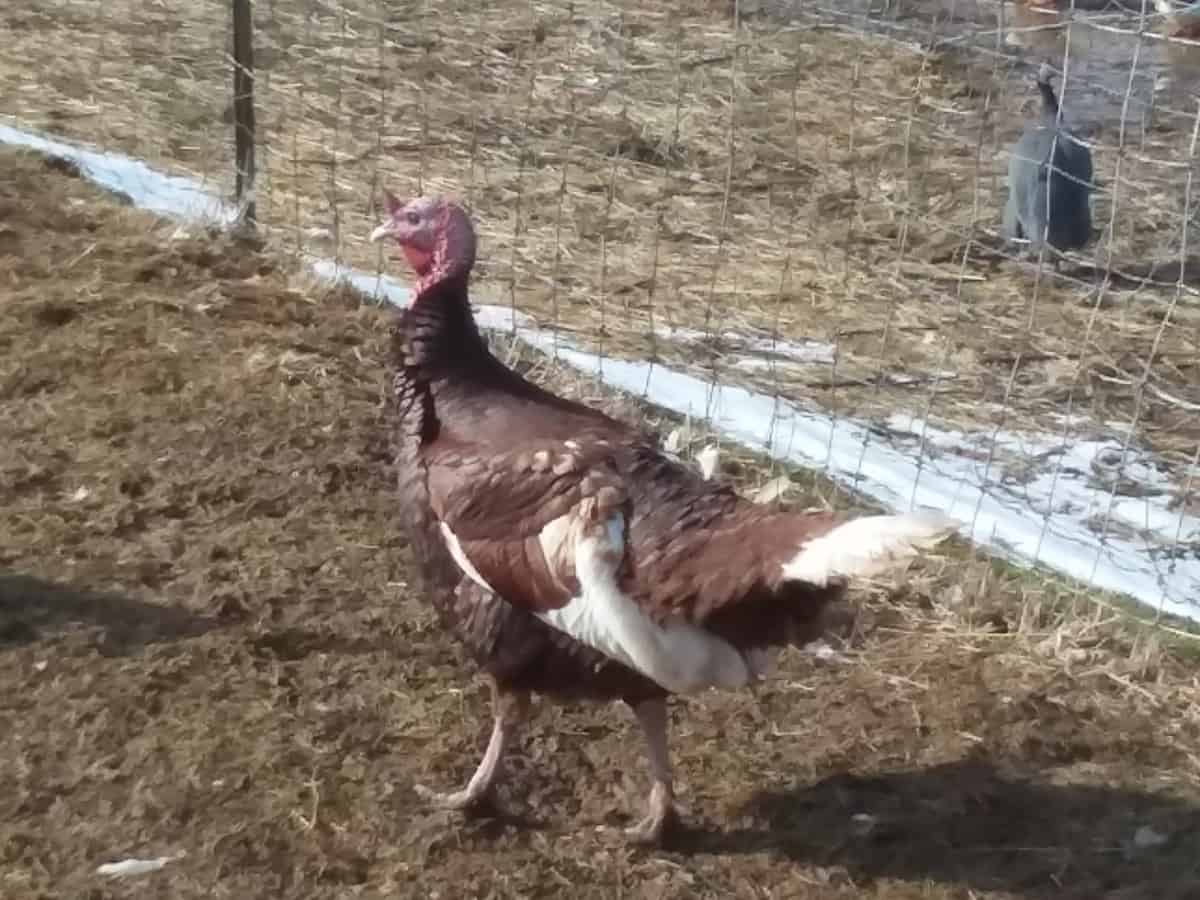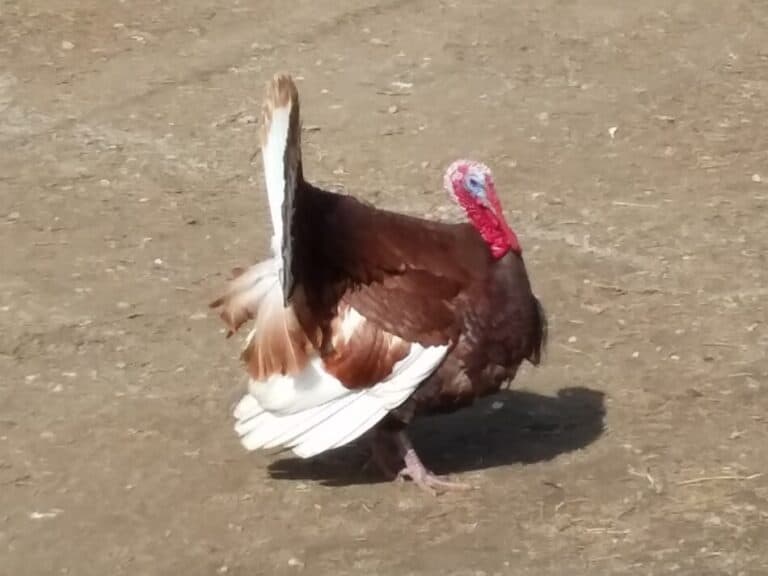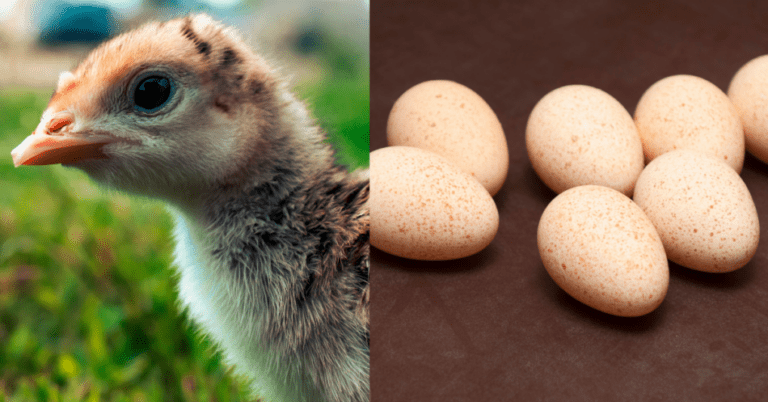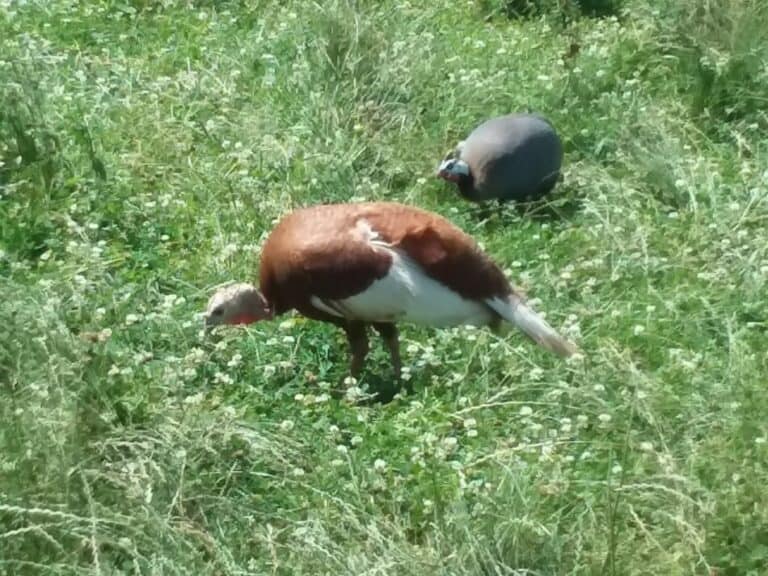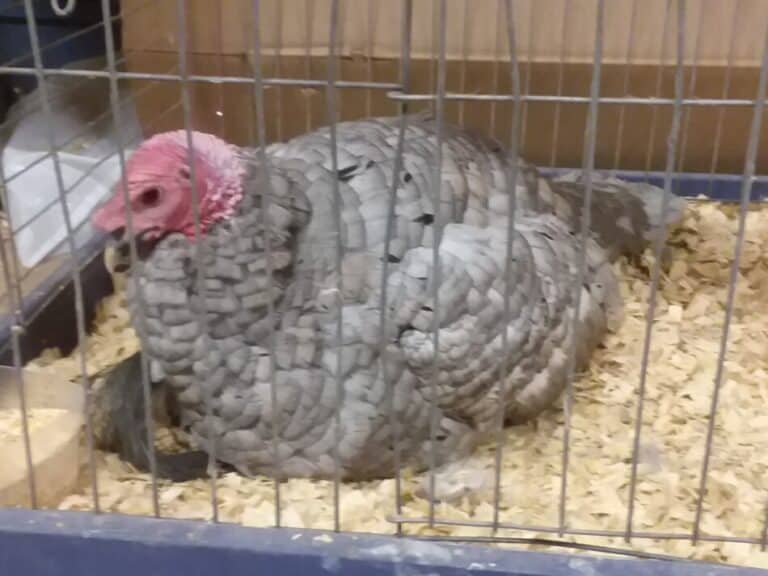10 Turkey Breeds For Raising Your Own Meat
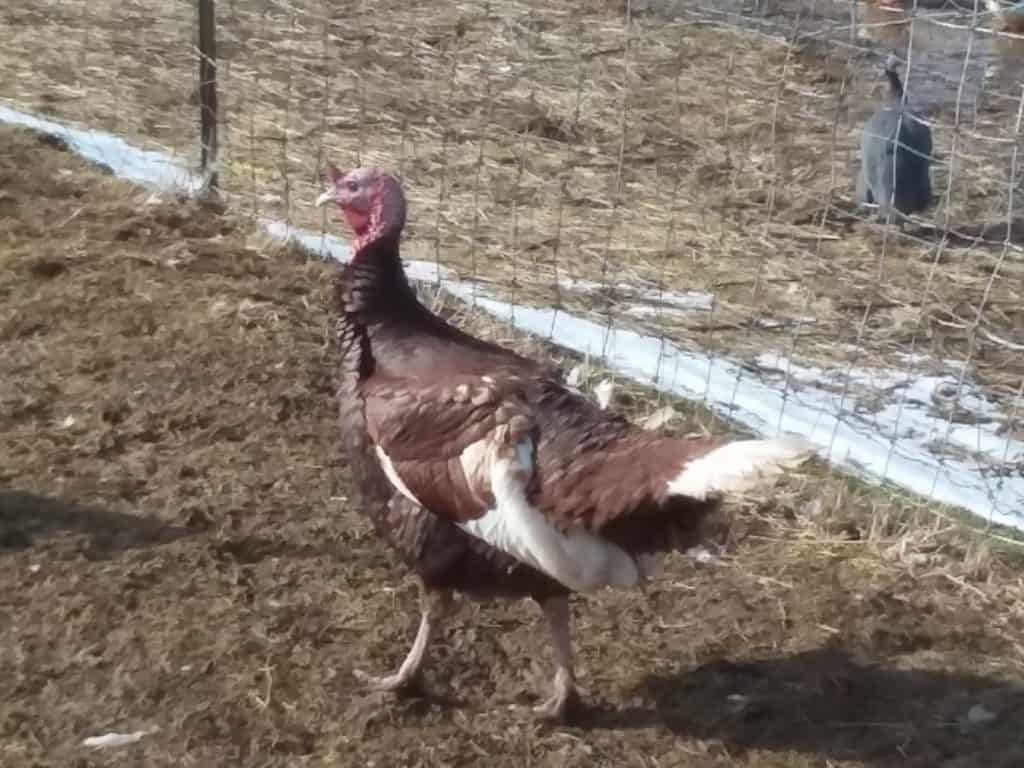
Raising your own turkeys is a fun and easy way to get a lot of flavorful meat for your family.
I love how much more meat you get per bird when you raise a turkey! Now the big question-what breed to choose?
Broad Breasted White Turkeys (the standard commercial turkey) reach butchering weight in 16 weeks. Heritage breeds will take 24 weeks or more and have a less meaty carcass, but more flavor.
Turkeys are easy to butcher. Why most folks don’t mention this is beyond me! Turkeys are just as easy as broilers to process and you get so much more meat!
Since turkeys have a bigger body cavity, they are easier to eviscerate. Turkeys also seem to have less feathers to pluck than a chicken, so plucking goes faster.
The Broad Breasted White turkey will reach butchering weight the fastest, generally in 16 weeks. The more traditional breeds will take longer, more towards 24 weeks.
Is Raising Turkeys For Meat Worth It? is an article I wrote giving you the costs to raise your poults. If you are wondering what to feed your poults, click here.
Each breed has desirable traits, so picking the best breed for you depends upon your preferences and your area available for the turkeys.
Turkey breeds you can raise have different characteristics
- Broad Breasted White (Giant White)
- Broad Breasted Bronze
- Bourbon Red
- Chocolate
- White Holland
- Midget White
- Narragansett
- Royal Palm
- Blue Slate
- Black Spanish
| Breed | Mature weight (in pounds) | Known for |
| Broad Breasted White | Toms: 45 Hens: 25 | fast growth and size all white in color |
| Broad Breasted Bronze | Toms: 45 Hens: 25 | fast growth and size brown feathers |
| Bourbon Red | Toms: 23 Hens: 14 | beautiful red color popular small flock choice |
| Chocolate | Toms: 30 Hens: 18 | easy going birds poults have white mask |
| White Holland | Toms: 25 Hens: 16 | classic white turkey look all white feathers |
| Midget White | Toms: 20 Hens: 12 | friendly, smaller birds often kept as pets |
| Narragansett | Toms: 23 Hens: 14 | calm birds good foragers |
| Royal Palm | Toms: 16 Hens: 10 | active birds that can fly kept for attractive looks |
| Blue Slate | Toms: 23 Hens: 14 | hardiness good foragers |
| Black Spanish | Toms: 23 Hens: 14 | active birds good foragers |
Broad Breasted White is also called the Giant White
The Broad Breasted White is the standard turkey that is raised commercially throughout the U.S. and the world.
The B.B. White’s popularity is well earned, because if you want a fast growing turkey to have meat as soon as you can (ready to butcher in 16 weeks!) these are the first choice by far.
No other breed can grow as fast or as big.
As you may have guessed, all that growth and massive body structure comes at a cost.
Their extreme size and weight makes them not able to take care of themselves at all, while they will forage some they must have plenty of feed.
B.B. Whites are not a good choice for any one who wants to hatch poults from their birds, since most can not breed naturally.
B.B. Whites are strictly for meat production.
Toms will weigh up to 45 pounds and hens up to 25 pounds. These are the turkeys you will see in the market turkey classes at the county and state fairs.
Broad Breasted Bronze are fast growers
The Broad Breasted Bronze turkey is the less popular but original colorful version of the Broad Breasted White.
If you are looking for a super fast growing bird for your freezer, but like a little more color in your pasture these might be for you.
The B.B. Bronze will grow just as big as the B.B. White, but it will have the potential for dark pin feathers to deal with.
The B.B. Bronze is colored like a wild turkey but much bigger in size, definitely impressive looking while roaming around.
Bourbon Red are great backyard turkeys
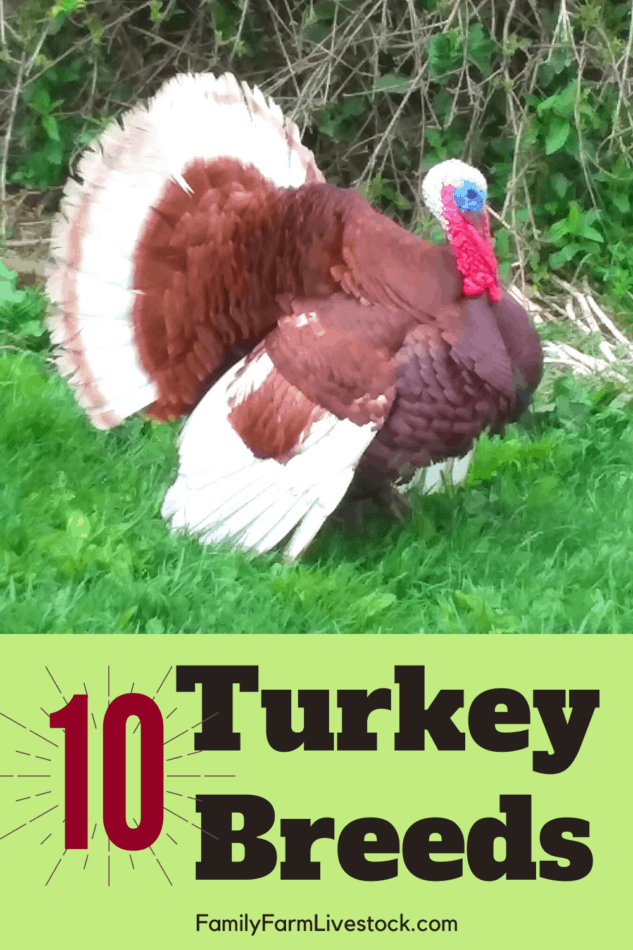
The Bourbon Red is a rich, chestnut red turkey that has pure white wing tips and tail feathers. They are originally from the Kentucky Bluegrass region and were first called Bourbon Butternuts.
Bourbon Red toms weigh 23 pounds and hens weigh in at 14 pounds.
We have a small flock of these birds and they are truly lovely. Ours roam all over foraging for bugs and grass. They are very capable and can get in trees and up on vehicles as well.
Bourbon Reds will hatch out their own poults and do a good job of it, too.
Where things fall apart is the hen will take off through the grass and come back with a few less babies everytime until she has one or none left!
Turkey poults don’t peep like chicks when they are lost so the mom doesn’t know they are missing. We always took away the poults and put them in a brooder so the babies would live to maturity.
The hen won’t stay with the poults in the brooder pen. Being in the pen freaks her out, so we let her leave so she doesn’t hurt the poults while she is upset.
Bourbon Reds are an active turkey that loves to forage around and tastes wonderful. We roast ours plain, no additions at all, super easy and they taste great!
Chocolate turkey poults have a white face
The Chocolate turkey is a breed that is named for it’s completely brown plumage.
They were a popular turkey in the southern U.S. before the Civil War. Now they are uncommon, but becoming more popular.
Chocolates are genetically a black bird that has slight change in the genes that determine color of the feathers. Interestingly, the poults have a white masked face when they hatch that fades to brown as they grow.
Chocolate turkeys are generally easy going birds. Toms weigh 30 pounds hens weigh 18 pounds.
White Holland turkeys are completely white
The White Holland turkey was the most popular turkey raised in America. These turkeys were officially recognized as a breed in 1874.
White Hollands were popular as a commercial turkey because they matured early and a white bird always plucks cleaner.
In the 1950’s White Hollands were crossed with the Broad Breasted Bronze turkeys to create the modern industrial white turkey so common today.
Most White Holland turkeys are used as show birds today. As meat producers they are rare.
These turkeys are always completely white in color. The weight of toms is 25 pounds and hens are 16 pounds.
Midget White turkeys are friendly
The Midget White turkey is a smaller breed of pure white turkeys, with the toms weighing 20 pounds and the hens weighing 12 pounds.
Midget Whites were developed in the 1950’s by Bob Smyth, by crossing Royal Palm and commercial Whites. Midget Whites are known for being very friendly and are frequently kept as pets.
Hens are naturally broody, and since they are a lighter breed they can naturally breed and hatch out their own poults.
Sometimes the Midget Whites are confused with the Beltsville Small White turkey, but they are completely separate breeds.
The Beltsville Small White is an exceedingly rare all white turkey that is the size of a larger breed chicken, whereas the Midget Whites are definitely a full size turkey.
Narragansett turkeys are good foragers
The Narragansett turkey is named after the Narragansett Bay in Rhode Island, which is where these birds originated. Narragnansetts were the main meat turkey raised in the New England states, as early as the 1700’s.
Narragansett turkeys are known for having a calm disposition, excellent meat quality, being good moms, and great foraging ability.
Toms will weigh 23 pounds and hens will weigh 14 pounds.
The color of a Narragansett is predominantly white and black, like a barred rock chicken. The feathers also have small amounts of grey and tan.
Narragansett turkeys are able to breed and hatch poults on their own (unlike commercial white turkeys). The eggs will be large with and light to medium brown with speckles.
Royal Palm turkeys are black and white
The Royal Palm turkey is a small, attractive bird. It is white with black edges to the feathers, black over the back and a black ring around the tail feathers.
Royal Palms are an active turkey. This means they can fly and are good foragers. Toms weigh 16 pounds and hens weigh 10 pounds.
The Royal Palms were selected for looks alone, which is why they are smaller than most and generally not considered a production breed.
Meaning if you want a small, easy care turkey Royal Palms are a great choice.
If you want a breed to raise for meat production you will probably be happier with a larger breed that has more meat.
Blue Slate turkeys are light grey
The Blue Slate or just Slate turkey is named for the coloring of the feathers.
They can have black flecks on the feathers, but otherwise Slate turkeys are solid colored. Hens will be lighter in color than toms.
Slate turkey toms will weigh 23 pounds at maturity and hens will weigh 14 pounds.
There has been a renewed interest in Slate turkeys since they do so well on pasture. Slate turkeys are known for great tasting meat, foraging ability and hardiness.
Black Spanish turkeys have a green tint
The Black Spanish turkey, also called Black or Norfolk Black turkey, is completely black in color with a green tinge to the feathers.
Toms weigh 23 pounds and hens weigh 14 pounds. These turkeys can be variable in weight since they have not been selected as a production breed.
Along with the other heritage breed turkeys, the Black has seen a renewed interest from turkey enthusiasts, both raisers and eaters alike.
People want healthy turkeys to raise and eat. Blacks are hardy, active turkeys with wonderful flavor.
You’ll need a brooder for your poults!
All baby poultry, turkeys included, will need a brooder.
A brooder is an area where they are kept warm, easily fed and watered and is safe from predators.
Anything that is a meat eater, including domestics like dogs and cats, love to snatch up a turkey poult (baby turkey)!
Have a space set up to keep your poults warm and safe. How To Get Turkey Poults To Eat And Drink will show you a few tricks to get your poults off to a great start!
For a look at a nice selection of turkey poults to raise, visit Meyer Hatchery. This is a link to their turkey page, you’ll choose the breed from here. Remember to order early, these poults sell out pretty fast.
If you are interested in the history of the breeds, look at The Livestock Conservancy for the full background on the heritage turkey breeds.
Resources: The Livestock Conservancy website; the Meyer Hatchery catalog; and the Murray McMurray Hatchery catalog
Related Questions
Do heritage breed turkeys taste better?
Heritage breed turkeys will have a more flavorful meat than a commercially raised turkeys if the heritage turkeys are raised with access to grass and are well taken care of.
What breed of turkey makes the best pet?
Consider the Midget White turkey if you want a very friendly turkey to have in your yard.
Are all turkeys white?
There are many different colors of turkeys in the U.S. Some breeds like the Midget White and the Broad Breasted White are always pure white.
Other breeds like Bourbon Red have some white feathers with a darker body color, and a few breeds like Blue Slate have no white feathers at all.
